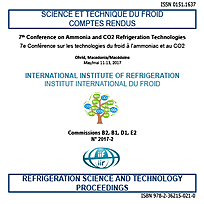
IIR document
The role of the lubricant chemistry in a R-744 refrigeration plant oil - return and lubricity. comparison between two chemistries using data from a real plant.
Number: pap. n. 0028
Author(s) : MUÑOZ ALONSO M., DIXON L., SEETON C. J., et al.
Summary
The lubricant plays an important role in the operation of a refrigeration plant, and understanding the effect of the lubricant is paramount. Since the lubricant is exposed directly to R-744, the solubility has to be balanced between enhancing lubricant flow when in the system so that oil return is sufficient for reliable operation, versus reduction in viscosity in the compressor due to R-744’s properties as an effective solvent. In addition to the lubricating properties, lubricants must also exhibit excellent chemical and thermal stability. There are two main barriers for the expansion Southward in Europe of R-744 refrigeration systems: the higher operating pressures (related to design robustness), and the maximum discharge temperature allowable by the lubricant to avoid its thermal breakdown. Two chemistries are available to the contractors for R-744 refrigeration plants design and operation: POE (Polyol-Ester) and PAG (Poly-Alkylene-Glycol). In this study, benefits and drawbacks of each chemistry will be explained, as well as practical points identified to help the technicians to select and work with the best operating conditions, including the maximum allowable discharge temperature. Using commercial grades properties and technical data for both ISO VG68 PAG and ISO VG85 POE, key properties (viscosity and percentage of R-744 dissolved in the oil) have been determined in each of the system components (gas cooler, evaporator, liquid reservoir, crankcase). This will enable the technicians to understand and take better decisions with the knowledge of what will happen once in operation.
Available documents
Format PDF
Pages: 8
Available
Public price
20 €
Member price*
Free
* Best rate depending on membership category (see the detailed benefits of individual and corporate memberships).
Details
- Original title: The role of the lubricant chemistry in a R-744 refrigeration plant oil - return and lubricity. comparison between two chemistries using data from a real plant.
- Record ID : 30021796
- Languages: English
- Source: 7th Conference on Ammonia and CO2 Refrigeration Technology. Proceedings: Ohrid, North Macedonia, May 11-13, 2017.
- Publication date: 2017/05/11
- DOI: http://dx.doi.org/10.18462/iir.nh3-co2.2017.0028
- Document available for consultation in the library of the IIR headquarters only.
Links
See other articles from the proceedings (42)
See the conference proceedings
Indexing
-
Themes:
CO2;
Lubricants - Keywords: Refrigerating system; Polyolester; Polyalkylene glycol; Comparison; Lubrication; R744; Physico-chemical property; Oil; Expérimentation
-
Evaluation of various compressor lubricants for...
- Author(s) : IKEDA H., YAGI J. I., KAWAGUCHI Y.
- Date : 2004/08/01
- Languages : English
- Source: Natural Working Fluids 2004: 6th IIR-Gustav Lorentzen Conference
- Formats : PDF
View record
-
An experimental study on oil return of PAG and ...
- Author(s) : LEE S. K., KANG B. H.
- Date : 2008/07/14
- Languages : English
- Source: 2008 Purdue Conferences. 19th International Compressor Engineering Conference at Purdue & 12th International Refrigeration and Air-Conditioning Conference at Purdue [CD-ROM].
- Formats : PDF
View record
-
Transient separation of refrigerant from oil/re...
- Author(s) : FUKUTA M., NISHIBU M., MOTOZAWA M.
- Date : 2017/07/20
- Languages : English
- Source: 8th international conference on compressors and refrigeration, 2017.
- Formats : PDF
View record
-
Characteristics of refrigerant-oil mixture: R29...
- Author(s) : TAKAHASHI H.
- Date : 2002/12/05
- Languages : Japanese
- Source: The International Symposium on HCFC Alternative Refrigerants and Environmental Technology 2002: Latest technology for Energy Conservation, Refrigerants and Recycling on Air-Conditioning and Refrigeration Equipment for the 21st century. Proceedings.
View record
-
Thermal cycle stability and lifetime estimation...
- Author(s) : PARK K. S., KANG B. H., PARK K. K., et al.
- Date : 2006/05/21
- Languages : English
- Source: ACRA-2006. Proceedings of the 3rd Asian conference on refrigeration and air conditioning.
View record
